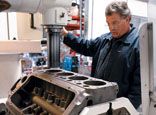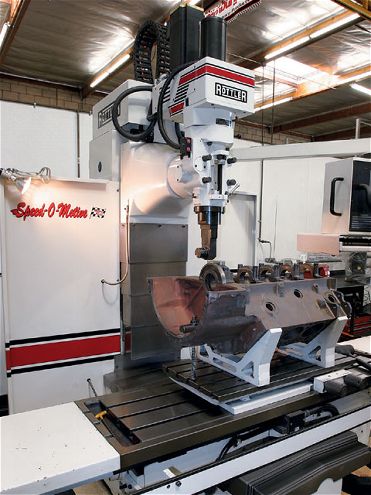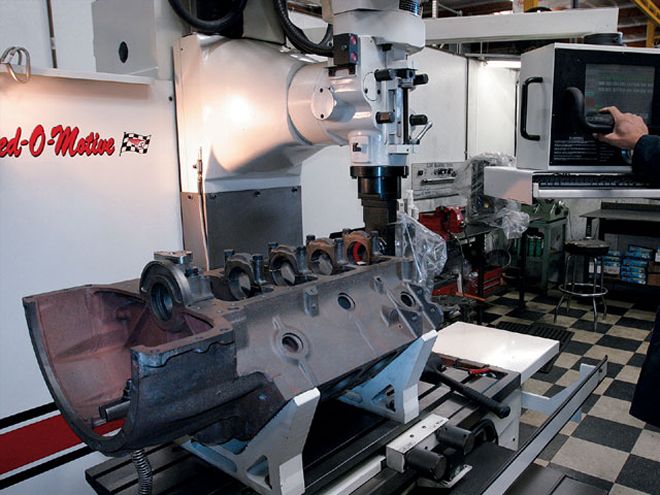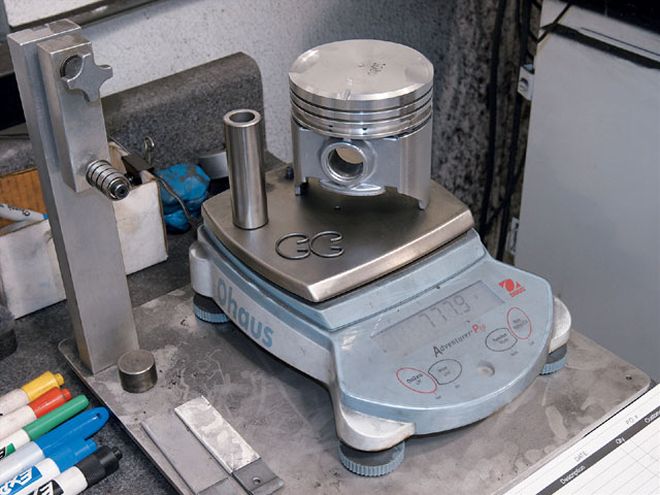
 With the block fresh out of the hot tank and passing inspection, it was ready for the first machining process, which in this case was line-boring the mains.
With the block fresh out of the hot tank and passing inspection, it was ready for the first machining process, which in this case was line-boring the mains.
Without a doubt, one of the most impressive-looking engines of all time would arguably be the Chrysler Hemi. But, before you get carried away with images of black wrinkle-finish valve covers installed on bright orange blocks and heads, there is something of which we need to remind you. The Hemi was around for 13 years before all these musclecar guys came in and stole the Fire Power's thunder. Most of us are aware of the origins of the early Hemi and the fact that not only did Chrysler use them to power some of its passenger cars, among other things, but so did Chrysler's Mopar sibling companies, DeSoto and Dodge.
By the time those bright orange engines were running NASCAR, the older Hemis had already been proving themselves on the streets, at the drags, and at the lakes for years. Just ask Don Garlits, the Chrisman brothers, or Fred Larson and Don Cummins, all of whom had very successful early Hemi-powered race cars in the 1950s and on. When Chrysler pulled the plug in 1958, the Hemi's reputation had already been firmly established as the motor to beat.
This would be all fine and good if this were 1958 and there were piles of engine in the junkyard or available at the local Mopar dealer. Problem is, it ain't 1958-it's 2008, and 50 years has passed since a first-gen block rolled off the assembly line. But, while the engines themselves are slightly more elusive than they may have been 50 years ago, there exists today a booming aftermarket industry that supports vintage engine builds, such as the early Hemi, perhaps in a more progressive way today than ever before. A number of the weak spots in those old engines have been addressed, like the water pumps, for which companies like Hot Heads offers adapters to run readily available small-block Chevy pumps in their place, as well as adapters for more transmissions than you can shake a stick at. And, internal items, such as pistons, bearings, seals, gaskets, rings, crank and camshafts, and even CNC'd aluminum heads, are all readily available.
 Speed-O-Motive uses Rottler CNC machines for just about every machining process. This speeds up the machining process incredibly by having all the specs pre-programmed into the machine's computer. Unfortunately, our extended bellhousing Hemi block was not one the company had done before, so a whole new program had to be written.
Speed-O-Motive uses Rottler CNC machines for just about every machining process. This speeds up the machining process incredibly by having all the specs pre-programmed into the machine's computer. Unfortunately, our extended bellhousing Hemi block was not one the company had done before, so a whole new program had to be written.
The point is, it's easier today to build up a reliable vintage engine like the Hemi than it's ever been. And, with every John, Dick, and Harry running small-block Chevy crate engines, dropping a vintage mill in your hot rod ensures your car will stand out from the crowd and separate you from the cookie-cutter street rods. In a hobby where it's nearly impossible for the average guy to build a hot rod in his garage that competes with what the pros are doing, dropping in a vintage engine ups the ante that little bit, which just may set your hot rod head and shoulders above the rest.
That was exactly my mentality when it came time to pick a mill for my '52 F-1 pickup. Sure, I could have ordered up a crate engine from any of the suppliers across the country, and I probably could have had my project on the road months ago, but who wants to take the easy way out? Always up for a challenge, and wanting to do something different (take my Project Potvin roadster as an extreme example), I set out hunting for a good candidate to power my truck. As luck would have it, I found one locally in a barn that looked pretty clean and didn't appear to be too worse for wear. The price was right, a deal was struck, and soon I was heading over to Speed-O-Motive with the engine in the back of my parts hauler to give those guys a thorough headache with my vintage gem.
 The piston assembly was also weighed, this time to determine the weight of the rotating mass to balance the crank. The pistons were already organized into sets according to their relative weights at Egge when they were machined, but a good machine shop will bring them within at least a half gram, just like the rods.
The piston assembly was also weighed, this time to determine the weight of the rotating mass to balance the crank. The pistons were already organized into sets according to their relative weights at Egge when they were machined, but a good machine shop will bring them within at least a half gram, just like the rods.
Speed-O-Motive has been known as the stroker experts since 1946, so there was no doubt in my mind that it would be the perfect choice to handle the machining chores. Another name synonymous with vintage engines is Egge Machine Company, who supplied all the internals for the Hemi, save the camshaft, the crank, the rods, and the springs. Egge runs a first-class business that casts pistons for everything from, well, Flatheads to Hemis, and also stocks every internal part you can think of for vintage engines from 1900 to 1980. A camshaft was ordered up from legendary Mooneyes, ground by the master himself, Bill Jenks. With a spec sheet with that much history, I was sure to be in good hands.
This month, we're going to cover the machining portion of the Hemi build, with the assembly and a few other tips to follow in the coming months. Stay tuned, and help us keep the Fire Power lit!